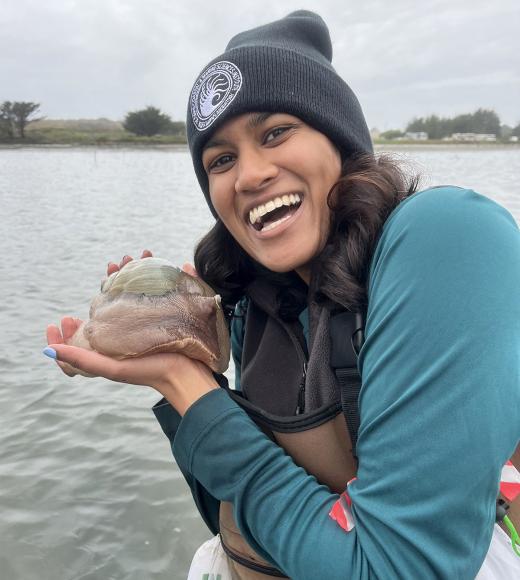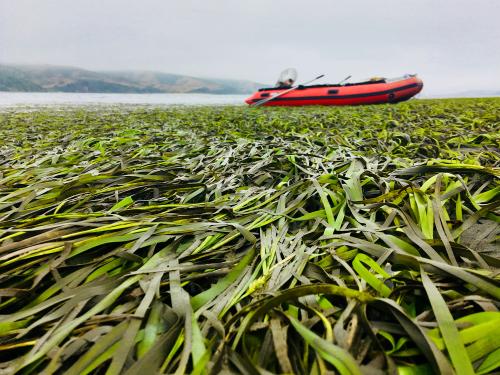
Celebrating Seagrass
World Seagrass Day 2024
In celebration of World Seagrass Day, we're highlighting seagrass-focused research conducted by UC Davis graduate students. Meet some of our dedicated scholars and delve into their research, exploring the significance of seagrasses and the implications for marine environments.
Serina Moheed
Ph.D. Student, Stachowicz Lab and Brown Lab, UC Davis Department of Evolution and Ecology

Serina monitors seagrass wasting disease in Northern California, and is currently investigating whether there are multiple strains of the slime-mold pathogen present in the Bodega and Tomales Bay estuaries. Seagrasses in these areas are known to be adapted to local temperature and light conditions, and Serina is combining lab and field experiments to understand whether this adaptation extends to protection against local pathogens. As a Nancy Foster Scholar, she works closely with the Greater Farallones National Marine Sanctuary and is hoping to create a map of disease hotspots that managers can use to inform their decisions on choosing donor populations for seagrass restoration projects.
Serina is currently conducting an internship at the California Academy of Science under Dr. Rebecca Albright through the Sustainable Oceans NRT at UC Davis. She is researching the effects of four treatments on coral larvae in the hopes of making them more climate resilient, and is immensely enjoying learning about a new study system and polishing her science communication skills.

Elisabeth Sellinger
Ph.D. student, Dr. Tessa Hill’s Ocean Climate Lab, UC Davis Department of Environmental and Planetary Sciences

Elisabeth Sellinger is looking at how blue carbon - which is carbon stored in the ocean - differs in natural, degraded, and restored seagrass meadows in Elkhorn Slough and Tomales Bay.
A combination of factors can cause seagrass meadows to deteriorate, including wasting disease, temperature, and human activity. As they degrade, their ability to capture carbon from the water column and store it in their surrounding sediments is compromised. Passive and active restoration strategies can reverse this damage and, in addition to the preservation of natural seagrass meadows, can improve carbon sequestration.
Working with the Monterey Bay and Greater Farallones National Marine Sanctuaries allows Elisabeth to dive into community based approaches to scientific exploration, and she hopes to continue to expand these connections as she works towards her doctoral degree.
Learn more about her work here: elisabethsellinger.weebly.com
Liyu Mekonnen
Ph.D. student, Dr. Alyssa Griffin’s CHANGE Lab, UC Davis Department of Environmental and Planetary Sciences

What’s the hardest part of working with seagrasses? They tangle up around your feet as you walk through them. Liyu Mekonnen says “You have to brace your core the whole time to keep from falling face down in the mud.”
But sometimes the mud is the most interesting part. Liyu is studying seagrasses and carbon sequestration by looking below the grasses to the sediments underneath. She’s hoping to document how seagrass meadows in different sediment types impact pyrite production and local buffering against the effects of ocean acidification.
Seagrass meadows are found on coasts throughout the world (except in Antarctica), but seagrass meadows in Northern California grow on silica-based sediments, as opposed to carbonate-based, which may impact their vulnerability to ocean acidification. However, the reduction of sulfate paired with the formation of pyrite can increase alkalinity in the sediments, boosting the seagrass meadow’s contribution to coastal carbon storage.
Claire Murphy
Ph.D. student, Stachowicz Lab, UC Davis Department of Evolution and Ecology
Who's coming to dinner? Seagrass meadows offer habitat and refuge for many marine organisms, but that also makes them appealing to a variety of predators. Fish, fowl, decapods, and pinnipeds all frequent seagrasses looking for a meal among the meadows.
Claire Murphy studies tiny crustaceans called amphipods and isopods. They play an important role in the seagrass by grazing on algae that grows on the leaves, allowing the grass to continue to get enough light to photosynthesize and grow. In return, the structure of the grass provides a place to hide from the many fish, bird, and crab predators that may try to eat them.
Claire is interested in how seasonal changes in the structure of seagrass influence how predators and prey interact within it. For part of her work, she has deployed GoPro cameras in seagrass beds around Tomales Bay and Bodega Harbor to see how predator communities change across the year. She reports that it's been a lot of fun and she has seen more animals than she ever imagined she would see using the seagrass as a home.
